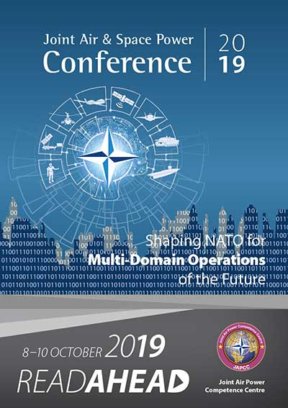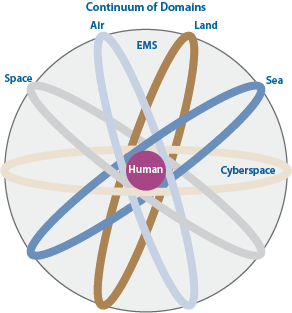Introduction
Many will have heard the phrase ‘Flexibility is the Key to Air Power’. Some will have heard the corollary that ‘flexibility’ is too rigid a concept and that it is actually ‘fluidity’ that is required; this is my starting point – Fluidity is the key to Multi-Domain Operations.
Domains
Those reading this will likely be familiar with the concept of domains (e. g. Maritime, Land and Air). Over the years we have developed our thinking on the concept of domains to include activity that takes place sub-surface and in Space and more recently, the Alliance has decided to consider Cyberspace as a domain. The first question that occurs is: In developing our thinking about the domains, have we also adequately developed our thinking about how we might operate within them? Or indeed: How might these domains be contested and by whom? The word ‘contested’ is used to suggest that there will be both aggressors and defenders and in the course of any contest, roles may reverse (i. e. the attacker is repulsed and subsequently becomes the defender). Understanding a domain is only a part of the challenge. Further, given the complexity of modern warfare, is it sufficient to understand only a single domain?
Beyond the Physical
To complicate the situation further, the physical domains of Land, Air, Maritime, and Space are generally well understood, to the extent that Joint Doctrine does not apparently see the need to define the domain. However, the non-physical areas of Cyberspace, the Information Environment, and the Electromagnetic Spectrum (EMS) are perhaps more difficult to both conceptualise and bound; below are offered definitions:
a. Cyberspace. Cyberspace is defined as a domain characterized by the use of electronics and the electromagnetic spectrum to store, modify, and exchange data via networked systems and associated physical infrastructures. According to this definition, cyberspace is a very real, physical domain that is comprised of electronics and networked systems that use electromagnetic energy. Cyberspace exists across the other domains of air, land, sea, and space and connects these physical domains with the cognitive processes that use the data that is stored, modified, or exchanged. Cyberspace is therefore distinct from the information that may be resident in or transferred through the domain (US National Military Strategy for Cyberspace Operations).
b. Information Environment. An environment comprised of the information itself; the individuals, organisations and systems that receive, process and convey the information; and the cognitive, virtual and physical space in which this occurs (AJP-3.10, Allied Joint Doctrine for Information Operations).
c. The Electromagnetic Spectrum. The Electromagnetic Spectrum (EMS) is the range of frequencies of electromagnetic radiation and their respective wavelengths and photon energies (Encyclopaedia Britannica).
Threat Considerations
During the Yom Kippur War, Israel lost a large numbers of aircraft to Egyptian Air Defences during the first few days of the conflict. These loses were due to Israel being caught by surprise and as a result, not being able to mount Suppression of Enemy Air Defences (SEAD) missions against Egyptian SA-6 surface-to-air missile systems. The problem was compounded as Israeli Air Force (IAF) radar warning receivers were not initially programed to detect the SA-6 radar. Were it not for the IAF’s size, resilience and ability to rapidly adapt, this event could have had game-changing results. The IAF learned the important lesson that Electronic Warfare had come of age; this was in 1973. Fast forward to the present and the era of multiple simultaneous and complex threats (360° threats), and many actors, state and non-state have access to complex technologies. As a result, the Operational Environment of today is very different to that of 1973.
Operational Environment
The Operational Environment1 of today will consists of factors and conditions that must be understood to successfully apply military capabilities, protect the force and complete any task. It extends beyond the physical boundaries of a defined area. The operational environment includes the sea, land, air and space, the enemy, neutral, friendly and other actors, facilities, weather, terrain, the EMS, CBRN2 threats and hazards, and the information environment (extracted from AJP-3.2, Allied Joint Doctrine for Land Operations). Most if not all of the factors that combine to create the Operational Environment, affect all of the domains and therefore, all of the military components; this is particularly true for the EMS as the Figure shown highlights:
At the centre of the diagram3 (left) sits the human and therefore human activity, to include warfare. If there is a relationship between all of the domains and all domains encroach into the EMS, is this not then the way that we should conceptualise modern warfare?
Current Doctrine – Current Thinking?
Having explored domains and the operational environment, we can turn to the components. How do the components currently view their primary role? Offered below are current definitions:
a. Maritime Power. Maritime power is derived from the ability of a state or non-state actor to use the freedom of movement provided by the sea to exert diplomatic, economic, and military influence at a time and place of choice. Maritime power has traditionally been employed globally to maintain the freedom of navigation essential to the general economic welfare or survival of states. Conversely, it has been regularly used to disrupt an opponent’s sea lines of communication (SLOC) as part of a wider Allied, joint, or combined operation (AJP-3.1, Allied Joint Doctrine for Maritime Operations).
b. Land Power. No such definition exists in NATO Doctrine (AJP-3.2, Allied Joint Doctrine for Land Operations). However, the following is offered for consideration: The use of the term ‘land power’ reflects the dynamism of the strategic environment over the past 15 years. Land power encompasses the employment of an array of land capability – from Army and across government – to achieve specified objectives. The Army must always view itself not in terms of simply ‘winning the land battle’, but as a force capable of exerting land power for strategic effect across the modern spectrum of peace, crisis and war. The term land power also raises Army’s concept of itself above this tactical ‘win the land battle’ and accepts that the generation of effects on the land also has strategic impact. It is multidimensional: land power may involve the employment of capabilities from all the operational environments (land, sea, air, space and cyberspace) to achieve results on land (extracted from Australian Land Doctrine).
c. Air Power. The ability to use air capabilities to influence the behaviour of actors and the course of events (AJP-3.3, Allied Joint Doctrine for Air and Space Operations).
It can be seen that only within a national definition of Land Power do we see the mention of other domains to include domains that are beyond the physical. Alliance forces are competent in the physical domains but, without simultaneous supporting activity in the non-physical domains or activity that is ill-defined, ineffectual, or non-existent, we risk opening serious if not critical vulnerabilities to our adversaries.
Relationship between Domains, Components and Threats
It is here that we encounter what was once not a question, or at least, not one that required serious consideration. Which Component operates in which Domain and against what threat? One may offer a simple answer. The Land Component operates in the Land Domain against a land-based threat etc. Today, however, given the ‘continuum of domains’ it is offered that even the most basic military activity takes place in several domains simultaneously. Therefore, to win in the Air, requires supporting activity in all the other domains to include secured access to Space and the EMS. This requires new thinking and new ways of operating.
Development of Thinking
If Alliance Air and Space Power is to be able to deliver effects from the Air at a time and place of our choosing (our asymmetric advantage and what our adversaries most fear), then we need both protection and support across all domains, physical and non-physical, if we are to be effective and resource efficient. That is to say, whilst projecting effects from the Air, we need to be simultaneously be protected and supported in each and every other domain and the threats that exist within that domain. Of course, a similar argument should be advanced for each of the other components. Freedom of Action within the Information Domain and within Cyberspace is now as important as Freedom of Manoeuvre in the physical domains; to achieve this requires mastery of the EMS. The EMS is required by all war-fighters, from basic radio operators to electronic warfare assets to satellite sensors. The sheer number of electronic devices in the battlespace, that function across a poorly controlled and coordinated EMS, are leading to routine blue-on-blue incidents of Electromagnetic Interference up to and including fratricide events. This will only be compounded if our adversaries deliberately attempt to deny friendly forces access to the EMS. Therefore: Is current thinking at the component level fit for the current operating environment? Going forward, understanding how to fight and win in each domain (or indeed pan-domain) is what the Alliance actually requires.
So What?
It is offered that we are now in an age where it is impossible to conceive of activity in any domain without considering what support or supporting activity is necessary in each of the other domains concurrently – a Complex All Domain Environment (CADE). Furthermore, the components will need to become increasingly agile across all domains in order to seamlessly transition from the supported to the supporting role. This is the synthesis of Multi-Domain Operations.
Summary
It is no longer sufficient for air forces to be masters of the Air. Yes this is the domain in which they project power but, in order to do so there needs to be mastery, both intellectual and physical, of all of the other domains. If deterrence is to be effective, or failing that, if we are to fight and win, robust analysis is required that seeks to answer the question: How does the Alliance achieve Domain Superiority? A further subtly is to explore: Is Domain Superiority required or, just a favourable situation for a specified time in order to achieve an objective and/or effect? Clearly, superiority, or a favourable situation, may be required in multiple domains concurrently or consecutively so, moving forward, Joint Campaign Synchronisation needs to evolve to become Multi-Domain Synchronisation; fluidity will be the key.












